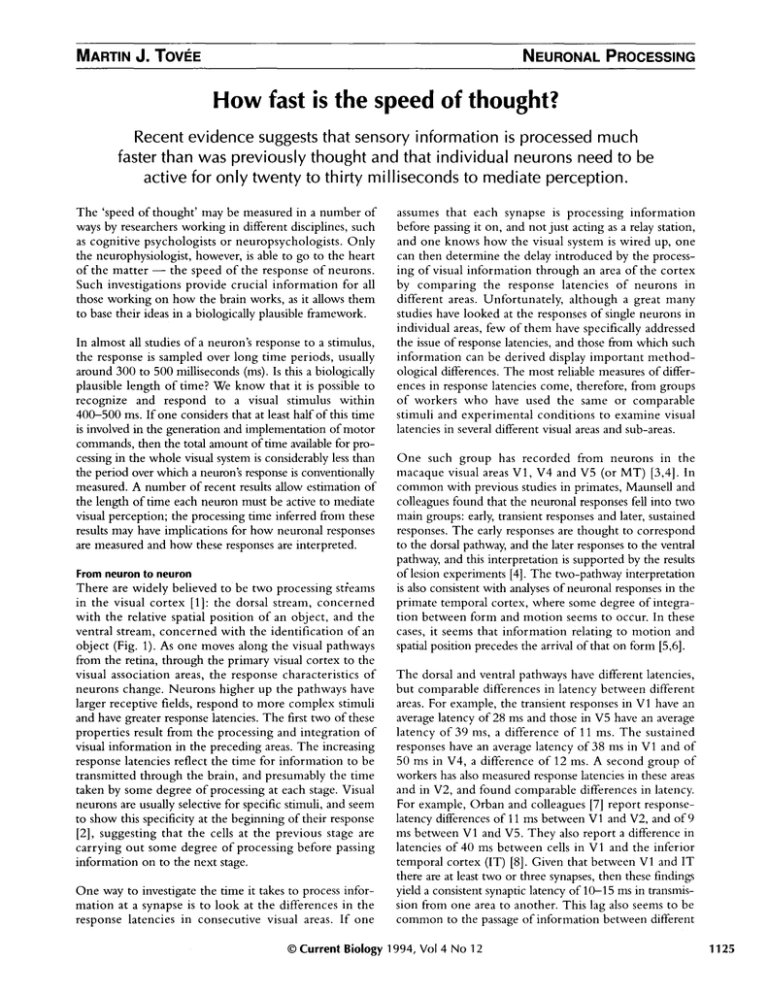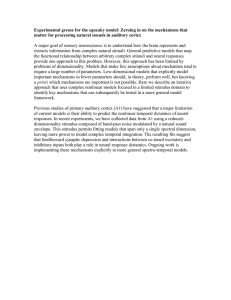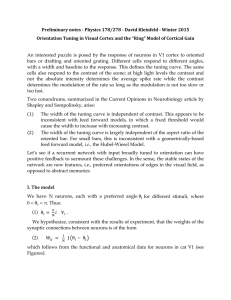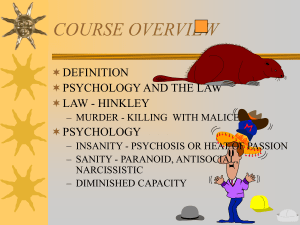How fast is the speed of thought?
advertisement

MARTIN J. TOVEE NEURONAL PROCESSING How fast isthe speed of thought? Recent evidence suggests that sensory information isprocessed much faster than was previously thought and that individual neurons need to be active for only twenty to thirty milliseconds to mediate perception. The 'speed of thought' may be measured in a number of ways by researchers working in different disciplines, such as cognitive psychologists or neuropsychologists. Only the neurophysiologist, however, is able to go to the heart of the matter - the speed of the response of neurons. Such investigations provide crucial information for all those working on how the brain works, as it allows them to base their ideas in a biologically plausible framework. In almost all studies of a neuron's response to a stimulus, the response is sampled over long time periods, usually around 300 to 500 milliseconds (ms). Is this a biologically plausible length of time? We know that it is possible to recognize and respond to a visual stimulus within 400-500 ms. If one considers that at least half of this time is involved in the generation and implementation of motor commands, then the total amount of time available for processing in the whole visual system is considerably less than the period over which a neuron's response is conventionally measured. A number of recent results allow estimation of the length of time each neuron must be active to mediate visual perception; the processing time inferred from these results may have implications for how neuronal responses are measured and how these responses are interpreted. From neuron to neuron There are widely believed to be two processing streams in the visual cortex [1]: the dorsal stream, concerned with the relative spatial position of an object, and the ventral stream, concerned with the identification of an object (Fig. 1). As one moves along the visual pathways from the retina, through the primary visual cortex to the visual association areas, the response characteristics of neurons change. Neurons higher up the pathways have larger receptive fields, respond to more complex stimuli and have greater response latencies. The first two of these properties result from the processing and integration of visual information in the preceding areas. The increasing response latencies reflect the time for information to be transmitted through the brain, and presumably the time taken by some degree of processing at each stage. Visual neurons are usually selective for specific stimuli, and seem to show this specificity at the beginning of their response [2], suggesting that the cells at the previous stage are carrying out some degree of processing before passing information on to the next stage. One way to investigate the time it takes to process information at a synapse is to look at the differences in the response latencies in consecutive visual areas. If one assumes that each synapse is processing information before passing it on, and not just acting as a relay station, and one knows how the visual system is wired up, one can then determine the delay introduced by the processing of visual information through an area of the cortex by comparing the response latencies of neurons in different areas. Unfortunately, although a great many studies have looked at the responses of single neurons in individual areas, few of them have specifically addressed the issue of response latencies, and those from which such information can be derived display important methodological differences. The most reliable measures of differences in response latencies come, therefore, from groups of workers who have used the same or comparable stimuli and experimental conditions to examine visual latencies in several different visual areas and sub-areas. One such group has recorded from neurons in the macaque visual areas V1, V4 and V5 (or MT) [3,4]. In common with previous studies in primates, Maunsell and colleagues found that the neuronal responses fell into two main groups: early, transient responses and later, sustained responses. The early responses are thought to correspond to the dorsal pathway, and the later responses to the ventral pathway, and this interpretation is supported by the results of lesion experiments [4]. The two-pathway interpretation is also consistent with analyses of neuronal responses in the primate temporal cortex, where some degree of integration between form and motion seems to occur. In these cases, it seems that information relating to motion and spatial position precedes the arrival of that on form [5,6]. The dorsal and ventral pathways have different latencies, but comparable differences in latency between different areas. For example, the transient responses in V1 have an average latency of 28 ms and those in V5 have an average latency of 39 ms, a difference of 11 ms. The sustained responses have an average latency of 38 ms in V1 and of 50 ms in V4, a difference of 12 ms. A second group of workers has also measured response latencies in these areas and in V2, and found comparable differences in latency. For example, Orban and colleagues [7] report responselatency differences of 11 ins between V1 and V2, and of 9 ms between Vi and V5. They also report a difference in latencies of 40 ms between cells in VI and the inferior temporal cortex (IT) [8]. Given that between VI and IT there are at least two or three synapses, then these findings yield a consistent synaptic latency of 10-15 ms in transmission from one area to another. This lag also seems to be common to the passage of information between different © Current Biology 1994, Vol 4 No 12 1125 1126 Current Biology 1994, Vol 4 No 12 sub-divisions of a given area. For example, there seems to be a lag of 15 ms between neurons in layer 4C and in the more superficial layers of V1, and a lag of 11 ms between viewer-centred cells and object-centred cells in the temporal visual cortex [4,9]. These results from primates Fig. 1. The top panel shows a simplified schematic of the parallel pathways in the primate visual system, running from the retinal ganglion cells (bottom) to the higher levels of the visual cerebral cortex (top). Lines show established pathways between the different areas. The bottom panel shows the two pathways superimposed onto a macaque brain. AIT, anterior inferior temporal cortex; CIT, central inferior temporal cortex; LIP, lateral intra parietal area; LGN, lateral geniculate nucleus; Magno, magnocellular layers of the LGN; MST, medial superior temporal area; Parvo, parvocellular layers of the LGN; PIT, posterior inferior temporal area; VIP, ventral intraparietal area; IT, inferior temporal cortex; PC, parietal cortex; V1-V5, visual areas. are comparable to results from the cat visual system, which show delays of 5-15 ms between different visual areas [10]. All the studies mentioned above report a considerable overlap in cell activity in different visual areas, such that most of the neurons at different stages in the visual system are simultaneously active [10]. It seems that a neuron is continually passing on information as it is processing it, rather than completing the processing and then passing the information on. Over a period of time, different factors will influence the processing of information at a synapse. Initially, the processing will be purely based on incoming information from the preceding areas (feed-forward information), but at varying times different feed-back mechanisms will play a modulating role. Initially, this will be in the form of lateral inhibition, followed by intra-cortical feedback and then feedback from higher areas. This would be consistent with what is known of human reaction-time studies. Simple detection of stimuli can be performed within 200 ms, whereas the recognition and discrimination of patterns leads to a lengthening of reaction times to 400-500 ms. This suggests that the longer an individual cell is active, the more sophisticated the information analysis will be. However, even with a reaction time of 400-500 ms for the recognition and discrimination of visual stimuli, there will still be only about 20-30 ms processing time per synapse. How fast can you see? Another way of looking at processing times is to examine the responses of individual neurons, and to determine at what point in their responses it is possible to discriminate between stimuli. For example, Thorpe and Imbert [11] recorded from orientation-selective neurons in the macaque striate cortex and found that orientation-tuning curves appear very similar if computed from the firing rate of either a 50 ms or a 300 ms sample. On the basis of data from cells in the temporal visual cortex, Oram and Perrett [2] have suggested that it is possible to discriminate between stimuli within 5 ms of the onset of the cell's response if one uses a large population of around 100 cells (a population size consistent with that suggested by other groups, see [12] for example). My colleagues and I [13,14] have carried out an analysis of the responses of face-selective cells in the temporal visual cortex using Bayesian information theory, which suggests that around 87 % of the information available in a 400 ms sample is available from a 50 ms sample near the start of a spike train, and that around 67 % of the information is available in a 20 ms sample (Fig. 2). The results of such studies suggest that most of the information encoded in a spike train is available in a short period at the beginning of the spike train. An alternative approach is to examine how the whole system functions if constraints are placed on how long it has to process a visual stimulus. Merely to make brief presentations of a stimulus is a poor method of deducing processing time, as the activity of visual neurons is not limited by the brevity of the stimulus presentation. For example, experiments by Rolls and me [15] suggest that DISPATCH occur is in the region of 20-30 ms. They also suggests that in the temporal cortex, at least, lateral inhibition starts to play a role in the processing of visual stimuli around 20-30 ms after the cell has begun to fire. Therefore, the early neuronal activity that mediates visual recognition and discrimination is based largely on feed-forward mechanisms, with minimal contributions from feed-back systems. Quick thinking Fig. 2. A graph showing the information available to a monkey at different times about the identity of a visual stimulus, based on 50 ms samples of the spike train of face-selective neurons. The time period over which each sample was taken is indicated by the length and position of each horizontal line. For comparison, the information available in 400 ms samples starting at 0 ms and 100 ms after stimulus onset is also shown. (Adapted from [14].) face-selective neurons in the primate temporal cortex will respond for several hundred ms to a face stimulus presented for only 16 ms. This finding is consistent with the results of psychophysical studies which have suggested that the neuronal representation of a pattern presented for a brief time period - less than 6 ms - outlasts the pattern's physical presence by anything from 400 to 1500 ms [16]. To measure the minimum amount of time required to process a visual stimulus, one must use either a task in which the subject has to respond to the visual stimulus as soon as possible (as discussed above), or a backwardmasking procedure, in which the presentation of a second image limits the time available to process the first. If a brief presentation of an image (the test stimulus) is rapidly followed by presentation of a second image (the mask stimulus), then perception of the test stimulus is impaired (masked) by the mask stimulus. Experiments by Rolls and me [15] suggest that the mask limits the time available at each synapse for processing information, which is consistent with the results of single-cell recording studies. Even when the mask stimulus follows the onset of the test stimulus at very short time intervals, pattern and object discrimination can still occur. For example, using face stimuli with an interval between the test and mask stimulus of only 16 ms, human subjects can recognize and discriminate face identity. Under the same conditions and using the same experimental apparatus [15], single-cell recording from rhesus monkeys shows that face-selective cells in the temporal cortex fire for only 20-30 ms. The mask stimulus - which does not stimulate the cell which is being recorded - has the effect of strongly inhibiting the cell's response, presumably by lateral inhibition. These results suggest that the minimum amount of time neurons at each synapse have to be active for stimulus recognition and discrimination to It seems that the rapid processing of visual information is facilitated by the continuous passage of information from one stage to the next during the processing of visual information. This allows information to be processed in parallel at different stages in the visual pathways, offset from the preceding stage by 10-15 ms. Most of the information seems to be encoded in the first 50-100 ms of neuronal activity, and 20-30 ms activity is sufficient for the identification and discrimination of even complex visual stimuli. In such fast processing, feedback mechanisms would play a limited role and most of the resultant information would be based on feed-forward mechanisms. Acknowledgements: I would like to thank M.P. Young, E.M. CohenTovee and S.D. Healy for a careful and critical reading of this article. References 1. Merigan WH, Maunsell JHR: How parallel are the visual pathways? Annu Rev Neurosci 1993, 16:369-402. 2. Oram MW, Perrett, DI: The time course of neural responses discriminating between different views of the head and face. I Neurophysiol 1992, 68:70-84. 3. Maunsell JHR: Physiological evidence for two visual subsystems. In Matters of Intelligence. Edited by Vaina LM. Dordrecth: Reidel; 1987:59-87. 4. Maunsell JHR, Gibson JR: Visual response latencies in striate cortex of the macaque monkey. I Neurophysiol 1992, 68:1332-1344. 5. Oram MW, Perrett, DI: Responses of anterior superior temporal polysensory (STPa) neurons to 'biological motion' stimuli. J Cog Neurosci 1994, 6:99-116. 6. Tovee MI, Rolls ET, Azzopardi P: Translation invariance in the responses of single neurons in the temporal visual cortical areas of the alert macaque. J Neurophysiol 1994, 72:1049-1066. 7. Raiguel SE,Lagae L,Gulyas B,Orban GA: Response latencies of visual cells in macaque areas VI, V2 and V5. Brain Res 1989, 493:155-159. 8. Vogel R,Orban GA: Activity of Inferior temporal neurons during orientation discrimination with successively presented gratings. J Neurophysiol 1994, 71:1428-1451. 9. Perrett DI, Hietanen JK, Oram MW, Benson PJ:Organization and functions of cells in the macaque temporal cortex. Phil Trans RSoc Lond [IBioll 1992, 335:23-50. 10. Dinse HR, Kruger K: The timing of processing along the visual pathway in the cat. NeuroReport 1994, 5:893-897. 11. Thorpe SJ, Imbert M: Biological constraints on connectionist modelling. In Connectionism in Perspective. Edited by Pfeifer R, 12. 13. 14. 15. 16. Schreter Z, Fogelman-Soulie F.Amsterdam: Elsevier; 1989:63-92. Young MP, Yamane S: Sparse population coding of faces in the inferotemporal cortex. Science 1992, 256:1327-1331. Tov6e MI, Rolls ET, Treves A, Bellis RP: Information encoding and the responses of single neurons in the primate temporal visual cortex. J Neurophysiol 1993, 70:640-654. Tovee MJ, Rolls ET: Information encoded in short firing rate epochs by single neurons in the primate temporal visual cortex. Visual Cognition 1994,1 :in press. Rolls ET, Tov6e MJ: Processing speed in the cerebral cortex, and the neurophysiology of backward masking. Proc RSoc Lond Biol] 1994, 257:9-15. Altmann L, Eckhorn R, Singer, W: Temporal integration in the visual system: Influence of temporal dispersion on figure-ground discrimination. Vis Res 1986, 26:1949-1957. Martin J. Tovee, Psychology Department, Ridley Building, Newcastle University, Newcastle upon Tyne NE1 7RU, UK. 1127







